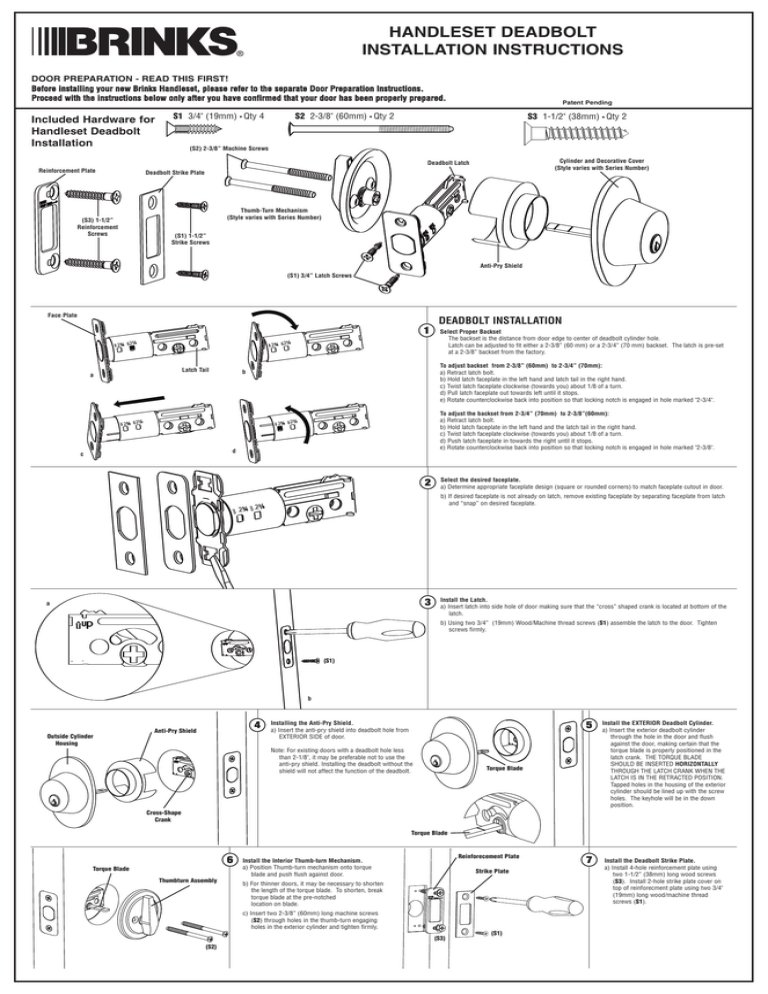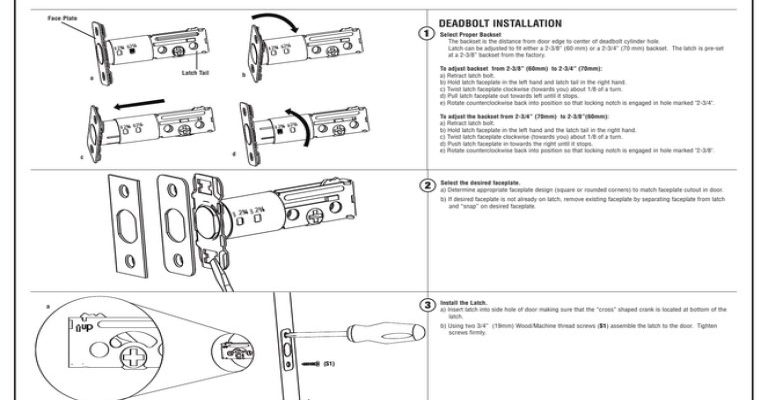
Here’s the thing: deadbolt alignment problems almost always feel trickier than they actually are. Maybe your lock worked fine for months, and suddenly you have to push, wiggle, or even slam the door for the bolt to fit. Or maybe you just installed a new handleset, and the deadbolt doesn’t seem to match up with the strike plate. In either case, you’re not alone—especially with so many handleset styles and brands on the market.
Let me walk you through why deadbolts go rogue, how to spot the root cause, and what you can do (with simple tools and a little patience) to get your lock set back in harmony again.
Why Handleset Deadbolt Misalignment Happens
You might be wondering why your handleset deadbolt, which used to work just fine, suddenly refuses to slide in smoothly. Honestly, it usually comes down to a handful of common culprits. The house settles over time, weather changes cause your wood door to expand or contract, or someone installed the set ever-so-slightly crooked in the first place.
Here’s something you might not realize: even a tiny misalignment—think the thickness of a credit card—can stop a deadbolt from throwing fully into the strike plate. If you have to lift, push, or pull the door to get the lock to engage, that’s a classic sign something’s off. Handleset brands like Schlage and Kwikset are popular for their sturdy construction, but they still require precise installation.
Don’t forget, frequent use can loosen screws or wear out the internal code mechanism, causing the bolt to start missing its mark. Sometimes, even a battery-powered smart deadbolt can drift out of sync if the alignment is off. That’s why it’s important to troubleshoot deadbolt alignment issues as soon as you notice them, before you end up locked out—or stuck inside.
How to Tell If Your Deadbolt Isn’t Aligned
Before you reach for tools, it helps to diagnose what’s really going on. Start by closing your door slowly and watching how the deadbolt lines up with the strike plate. Does it need a little manhandling just to line up? Does the bolt hit the metal plate below or above the hole? If so, there’s a clear misalignment.
Some clues are easy to spot: paint rubbed off around the strike, deep scratch marks, or visible gaps when the door is closed. In other cases, you’ll feel resistance when you turn the key or thumbturn—especially when the door’s pulled tight by the latch. With some smart locks, the “code” or “pair” features may not work at all if the bolt can’t fully extend, triggering a reset or battery warning.
Here’s a simple test: with the door open, throw the deadbolt in and out a few times. It should move smoothly. If it sticks only when the door is closed, you know the problem is with the alignment between the bolt and the strike plate—not with the lock mechanism itself.
Step-by-Step Troubleshooting for Handleset Deadbolt Alignment
Fixing a misaligned deadbolt isn’t rocket science, but it does require a methodical approach. Let’s break it down step-by-step:
- Check the hinges: Loose or sagging door hinges can drag your whole door out of line. Use a screwdriver to tighten all the hinge screws. If the screws strip, replace them with longer ones for a stronger grip.
- Inspect the strike plate: Is the hole in the strike plate big enough for the bolt? If not, you might need to file it slightly. Sometimes you can see where the bolt is hitting—look for shiny metal or scraped edges.
- Adjust the strike plate position: If the bolt is hitting too high, low, or off-center, try loosening the strike plate screws and shifting it ever so slightly. Retighten the screws and test the deadbolt. Sometimes, moving the plate just a couple millimeters makes all the difference.
- Realign the handleset: If your whole lockset feels off, the latch and deadbolt might not be lined up vertically. Loosen the screws on the handleset, nudge it into better alignment, and re-tighten.
Take your time. Test the deadbolt after each change. And remember, patience is your friend—the reward is a satisfying, smooth-turning lock.
When to Adjust, Replace, or Reset Your Handleset Deadbolt
Not every misalignment has the same fix. Sometimes a quick adjustment does the trick, but other times you may need to replace parts or even reset your lock. Especially with smart or electronic deadbolts, alignment issues can cause your “code,” “sync,” or battery features to act up.
If adjusting the strike plate doesn’t solve the problem, double-check that the handleset itself isn’t damaged or bent. For brand-name sets like Kwikset SmartCode or Schlage Connect, you can often reset the lock settings after realigning the hardware, syncing everything so it works smoothly.
Here’s a tip: if you’ve forced the deadbolt for weeks, check for internal damage. Bent bolts or worn-out mechanisms won’t align, no matter how much you adjust the strike plate. In that case, replacing the deadbolt mechanism (available at any hardware store) might be faster and safer than fighting with stubborn parts.
If you’re not getting anywhere, don’t be afraid to call a locksmith. Sometimes a fresh set of eyes spots what you’ve missed after hours of troubleshooting.
Comparing Brand Handlesets: Are Some More Prone to Deadbolt Alignment Issues?
You might be curious if some handleset brands are more fussy than others when it comes to deadbolt alignment. Honestly, while there are slight differences in quality, most modern handlesets—Schlage, Kwikset, Defiant, Yale, and off-brands—use a similar mounting system.
Here’s what sets them apart:
- Schlage: Known for precise machining, but their heavy-duty bolts require exact alignment. Even a slight miss and you’ll feel the resistance.
- Kwikset: Often praised for easy re-key and smart features, but their adjustable latches still demand a proper fit.
- Defiant: Budget-friendly, but sometimes the strike plates are a bit thin, so they can warp under pressure.
No matter the brand, poor installation is the number one reason handleset deadbolts fall out of alignment. Universal deadbolts can be easier to replace, but they don’t always match the original cutouts—leading to fresh alignment headaches.
Tools and Quick Fixes for Aligning a Handleset Deadbolt
Most deadbolt troubleshooting doesn’t require a fancy toolbox. You’ll need:
- Phillips head screwdriver (for tightening or adjusting screws)
- Flat file or rasp (for widening the strike plate hole if needed)
- Wood shims or toothpicks (to reinforce loose screw holes in door frames)
- Replacement screws (preferably longer ones for deeper anchoring)
- Pencil (for marking the true bolt position on the frame)
If your handleset has smart features, have a fresh battery on hand—sometimes a low battery can make the motor seem weak, exaggerating alignment problems. And always test the lock with the door open and closed to isolate whether the issue is with the lock or the frame.
Preventing Future Handleset Deadbolt Alignment Problems
Once you’ve wrangled your stubborn deadbolt into place, you’ll want to keep it that way. Here’s my advice: check your door’s hinges and strike plate every few months, especially after a season of wild weather. Doors swell and shrink, wood warps, and even aluminum frames can shift over time.
Tighten your hinge screws once or twice a year and wipe down your deadbolt to keep dirt and grit from getting in the way. If you’re installing a new handleset, give yourself time to measure carefully. Don’t rush—lining up the latch and bolt perfectly now is much easier than troubleshooting later.
If your handleset includes smart lock features, keep an eye on sync and battery status, and follow your brand’s reset instructions after any major adjustment. A little routine maintenance beats a late-night lockout every time.
Final Thoughts on Getting Your Handleset Deadbolt Aligned
Troubleshooting a handleset deadbolt that won’t align can feel like a minor trial by fire, but it doesn’t have to ruin your day. Most issues come down to small shifts in your door or a strike plate that’s just a hair off. With a few common tools, a patient approach, and a careful eye for detail, you can get your lock working smoothly—no matter if you’re using a Schlage, Kwikset, Defiant, or another brand.
Take it step by step. Focus on each part of the set—hinges, strike plate, handleset alignment, and, if needed, a code or battery reset for smart models. If you run into something stubborn, don’t hesitate to call in help. And once you’ve got everything realigned, a little regular checking keeps your deadbolt trouble-free and your home secure.
